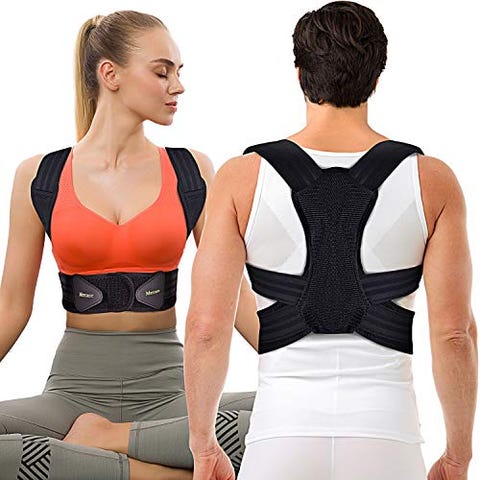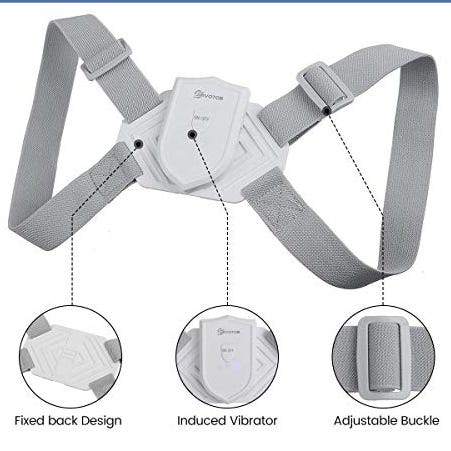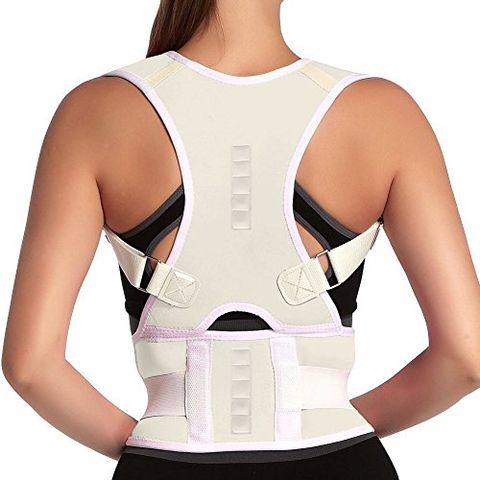Posture Corrector Adjustable Clavicle Shoulder Upper Back Support Brace Improve
Okay, admit it: You sit at a desk most of the day or hunched over your phone DMing memes to your friends. By the time you're home for the evening, you have some serious aches in your back, shoulders, and neck. Your posture could probably use some work, let's be real.
There is such a thing as *bad* posture, and slouching or bending your spine in strange ways all the time can hurt you physically and psychologically, says Dave Smith, a postural alignment specialist and consultant for the San Francisco 49ers, many NCAA players, and the U.S. Women's Tennis Association.
Bad posture can make your muscles imbalanced, weak, or too tight which can lead to pain, degenerative joints and discs, injuries, and even osteoarthritis, he says. But let's get into more detail—and solutions.
Why does good posture matter?
"Good posture is essential to good musculoskeletal health," says Pamela Mehta, MD, board-certified orthopedic surgeon at Resilience Orthopedics. "When the spine is aligned properly through good posture, it allows for proper stacking of your bones, muscles, and ligaments." This leads to better balance and ability to function during normal daily activities such as running, walking, standing for long periods, and lifting.
Bad posture can put strain on your muscles and joints, which can be painful—and wreak havoc on your whole body. "When the head falls out of line of the pelvis, the muscles automatically work overtime to try and re-center the head over the pelvis," adds Rahul Shah, MD, FAAOS, board-certified orthopedic neck and back surgeon. "As the muscles work overtime, they will become fatigued, and this can result in back or neck pain."
This content is imported from {embed-name}. You may be able to find the same content in another format, or you may be able to find more information, at their web site.
If you're looking to train yourself to sit and stand with proper posture, your first instinct may be to try one of those posture-correcting devices you've seen advertised all over social media. But do posture correctors really work? There are pros and cons, experts say.
What should I look for in a posture corrector?
There are different types of posture correctors. Some are physical correctors, like braces, that manually hold your shoulders and back in alignment. There are also apps and gadgets on the market that help send you little reminders to stop slouching. (With these, you still have to be the one to fix your own posture.)
Posture support tools may be helpful for some people, experts hear anecdotally. But there's no scientific data that posture-support tools make a significant difference, says Neel Anand, MD, professor of orthopaedic surgery and director of spine trauma at Cedars-Sinai Spine Center in Los Angeles.
While they're not a magic wand for taking you from Neanderthal to ballerina, posture correctors *can* help you find your best posture and make you more aware of how you're sitting and standing day to day when used in tandem with a strengthening program, and for a limited amount of time. "The real benefit of these devices is that they bring your awareness to your posture and that alone can reduce pain and increase confidence," Dr. Anand says.
Look for a posture corrector that is:
- Comfortable
- Non-rigid (meaning it doesn't force your body into a position that causes any pain or discomfort)
- Gentle
One important note: If you use these gadgets *too* much—particularly physical braces—then your muscles may become dependent on them and actually weaken, worsening your posture in the long run, says Smith, who is also a therapist with the posture therapy clinic Egoscue.
"This is why it's so important to use any posture device in conjunction with a posture-strengthening exercise routine," he says, adding that a good posture program should target the muscles in your core, hips, glutes, lower back, and upper back. (You can start with these exercises designed to improve your posture.) Ideally, you should limit your use of posture correctors to just an hour a day.
Here are some of the most popular devices and styles on the market, so you can pick the best fit for your needs and lifestyle.
1. Clavicle, Chest, And Back Support Brace

Amazon
Berlin & Daughter amazon.com
$29.95
These posture correctors are basic and easy to use—not to mention, easy to find. You may be able to get one from your physical therapist's office, or you can search on Amazon to find options (like the one to the right!).
Just slip it on over your shoulders, and it wraps around your upper back. It almost feels like you're wearing a bra backwards. This is a good thing, as this device helps to counteract the effect of the weight of your breasts pulling your chest and front side forward, Smith says.
Out of all of the physical posture support devices, this one provides the lightest support but is also the most comfortable and the least visible under clothing.
2. Double Strap Posture Corrector

Mercase amazon.com
$23.99
This double strap back brace has a waist strap and another elastic belt to offer extra lumbar support and comfort as you wear it. It also has two auxiliary support bars in the padded back strip for added structure.
One reviewer commented on Amazon, "I put it on the first time and my 9 year old came in the room a minute later and exclaimed I had grown taller somehow."
3. Eivotor Posture Corrector Trainer

This smart posture corrector is made of an ergonomic elastic and nylon material that fits over your shoulders. It also comes with a sensor that vibrates when your posture is out of alignment to help you establish muscle memory and develop a habit of straightening with a gentle reminder.
One Amazon reviewer noted, "The 'out of posture' vibration is significant and really gets your attention to straighten up. It works extremely well!!"
4. Upright GO Electronic Posture Trainer

Upright GO
Posture Trainer and Corrector
Upright GO amazon.com
$149.99
If all you need is a gentle reminder to alert you when you're slouching, you can try one of the wearable devices, Smith says.
These attach either via a clip to the front of your bra or with adhesive to the skin on your upper back and vibrate when your posture starts to slip. Some also come with an app for your phone so you can track your stats over time.
Keep in mind that these are more expensive than standard braces and require charging or batteries but they're invisible under clothing. If you like the idea of having a posture reminder during the day but don't want to spend the money, you can set up your watch to alert you at specified intervals.
Once an hour, set a smartphone alert that instructs you to check your posture as well as take a break to stand, walk, and stretch. "Our sedentary lifestyle is one of the main reasons for back pain and the best thing you can do is get more motion," says Smith.
5. Molded Upper Back Brace

Amazon
Adjustable Upper Back Corrector Brace and Posture Trainer
SKYWEE amazon.com
These braces are worn similarly to the elastic brace but include a stiff plastic or metal piece that sits vertically between your shoulder blades.
A molded brace tends to offer more adjustable, firmer support and gives a solid reminder to pull your shoulder blades back to counteract your tendency to hunch over your computer or phone, Smith says.
The issue? The bulkier style of this brace means it can show through clothing. But given that you don't want to wear physical braces 24/7 anyway (because your muscles may get too used to them and grow weaker), you could wear this around the house for shorter intervals and leave it off when you're wearing something more form-fitting in public.
6. Longline Back Brace

Amazon
If your posture is seriously out of alignment or you have existing low-back pain, you may prefer a longline brace that provides support from the base of your neck to the top of your hip, Dr. Anand says.
You slip this one over your shoulders and then wrap a wide piece of elastic around your low back and stomach. One thing to note: It provides very firm support throughout your back, but it can be quite visible through clothing, similar to the option above.
7. Adjustable Upper Back Brace

Posture Corrector for Men and Women
Lorchar amazon.com
This seamless back brace also focuses on the upper back, and comes with adjustable straps for a custom fit.
A bonus: It also comes with a drawstring bag to store it in.
"Rather than forcing me to sit up, it serves as a constant reminder to sit up, which works just as well. The straps are nice and sturdy," one Amazon reviewer noted.
8. Magnetic Back Brace

Amazon
Magnetic Back Brace for Slouch and Posture Support
I&Y BUY amazon.com
$19.75
Many popular brace styles claim that strategically positioned magnets within them have pain-reducing powers. While that sounds...pretty unlikely...magnet-containing braces are not harmful if you like how they feel (some reviewers say the weight of the magnets feel relaxing or soothing).
One Amazon reviewer said, "I've only had this for a few days but can feel a difference already." Another wrote, "This guy became my best friend recently. After nine hours in the office sitting in front of the computer, it's such a relief for my back!"
And if the brace helps you remember to correct your posture then they're totally fine, Smith says. "There is no research that adding magnets to a back brace helps in any way but I've heard anecdotal reports from patients who've said they like it," Smith says.
9. Strong Support Brace

Posture Corrector Back Brace
SUPERBE amazon.com
If you're looking for extra support, this brace is for you. It is enforced by two wide steel support plates contoured along the spine that covers your entire back. One Amazon reviewer said that they had "relief within minutes" after wearing.
10. Magnetic Lumbar Back Support Belt

Thoracic Back Brace Posture Corrector
MOHUACHI amazon.com
$23.66
This brace has 10 magnets that cover your entire back, all the way from the shoulders to the lower lumbar.
One Amazon reviewer wrote, "I have been working on exercises to strengthen my posture muscles, but this brace is just what I was looking for for the final push."
Emily Shiffer Emily Shiffer is a former digital web producer for Men's Health and Prevention, and is currently a freelancer writer specializing in health, weight loss, and fitness.
This content is created and maintained by a third party, and imported onto this page to help users provide their email addresses. You may be able to find more information about this and similar content at piano.io
Posture Corrector Adjustable Clavicle Shoulder Upper Back Support Brace Improve
Source: https://www.womenshealthmag.com/health/a28385621/best-posture-correctors/
0 Response to "Posture Corrector Adjustable Clavicle Shoulder Upper Back Support Brace Improve"
Post a Comment